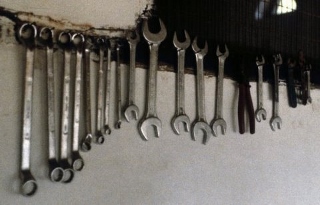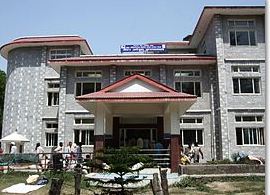I struggled with my gender conflict for 40 years before I had the courage to begin the journey to repair it, once and for all. During those 40 years, I found solace in travel, circling the globe three times, working abroad and living in very different cultures to help relieve my anxiety and stress. It was just easier to be myself outside of my normal environment, and while the pressure was no less intense, my perception of it shifted enough to allow me a respite. I've since learned that I'm not the only one to use this coping mechanism.
One of those trips followed the completion of my ophthalmology residency in 1982, when my ex and I ended up in Nepal. I went to work for the World Health Organization's (WHO) Nepal Eye Project, performing eye surgery in Dhangadhi, Nepal, far to the west of Katmandu. I got to help those residents of the Himalayas who had never before seen an eye surgeon, and who were not only legally blind, by Western standards, but totally blind -- what we call "bare light perception." These patients came down from the mountains single file, holding on to the one in front, the blind literally leading the blind, and presenting with "ripe" cataracts, a total opacification of the lens rarely seen in the United States even in 1983. It was extremely satisfying to make such a huge difference so quickly in the lives of so many, many of who told me they had never expected to see again.
 This was the hospital when I served there, with the instruments hanging on the wall. No, I'm kidding, but the surgical tools were nearly as primitive and limited as that strip of wrenches which did hang on the operating room wall.
This was the hospital when I served there, with the instruments hanging on the wall. No, I'm kidding, but the surgical tools were nearly as primitive and limited as that strip of wrenches which did hang on the operating room wall. A recent episode of Grey's Anatomy showcased a similar situation with Syrian physicians emulating the battlefield conditions under which they must operate in their civil war. Today, this is the new hospital in the photo below, providing much higher quality care with better equipment and routinely staffed with trained personnel.
A recent episode of Grey's Anatomy showcased a similar situation with Syrian physicians emulating the battlefield conditions under which they must operate in their civil war. Today, this is the new hospital in the photo below, providing much higher quality care with better equipment and routinely staffed with trained personnel.
While I was operating in western Nepal I could bury myself in my work, pushing aside the desire to just finally come out and transition. One experience in Nepal exemplified my inner conflict, and that was the Passover seder we created in Katmandu that year. Being different, hiding that difference, or even simply covering that difference, applies to many forms of diversity. There is nothing singular about being trans, or gay, or Jewish, when it comes to différance. What holds for one aspect of the human condition holds for any other.
When my ex and I traveled, and we traveled a lot, we weren't traveling as Jews, or Jewish Americans. We were young adults who identified as travelers, rather than tourists, spending time in different cultures to which we contributed our work in exchange for the experience of living with others. We would seek out Jewish cultural institutions abroad, and connect with families on occasion, but we were just Americans, doing what many of our generation did during the 70's and 80's. When we passed through Muslim territories or nations, we particularly covered our heritage, out of fear. Occasionally we even hid the fact we were Americans, posing as Canadians or Finns. It seemed silly at the time, but considering that we were in Kabul just before the Soviet invasion and Tehran just before the Khomeini coup in 1978, in hindsight it doesn't appear silly at all.
That mindset worked until Passover approached. A that point the desire for a seder, even what felt like a physical need to participate in one, grew so intense that we were willing to break cover and organize the event in what seemed to be an environment alien to such a religious and cultural practice. At first coming out was difficult, and my initial steps were awkward. But within a day I was biking around the city and its suburbs looking for other Jewish travelers to invite to the seder. I found five the first day studying in a Buddhist monastery, and we didn't stop there, posting invites around town. It was a rather gutsy action, in such an isolated country, but the act of coming out had opened many opportunities to connect to the resident culture and ultimately allowed for an experience which could not be replicated again. Even today, when the seder routinely attracts over 1000 guests, I have a feeling the experience is nothing like that first time. Usually no experience is.
My theme is that authenticity is a worthy goal, even though at times it is dangerous to be authentic, as when she and I covered our Jewish and American backgrounds while in Pakistan and Iran, or when I buried my true gender for the first five decades of my life. Those situational compromises may have been necessary at the time, but I know I paid a heavy price. That is why I encourage everyone to live authentically, even when there may be serious costs, because in so doing we improve conditions for everyone and that redounds to our benefit in the long-term as well.
Lynn Conway, a friend of mine from Eve Ensler's all-trans production of The Vagina Monologues in 2004, whom I consider one of the iconic role models of the trans community, and who is one of the creators of our modern digitally connected world, is just now coming out fully and reclaiming her position and legacy. I don't know where we'd be today without her -- still waiting in line to submit our batch cards for mainframe processing? -- and her courage in transitioning back in 1968 fills me with awe. I understand her reticence which led her to live a covered life throughout her career in an overwhelmingly male-dominated profession, but I'm thrilled now that she's going public, not only for her but for the further impact she will have on the trans community and the larger culture, particularly young women, as well. We need more role models like Lynn, and I'm proud to be her friend.

